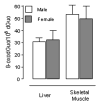Evaluation of sex differences on mitochondrial bioenergetics and apoptosis in mice
- PMID: 17118599
- PMCID: PMC1817668
- DOI: 10.1016/j.exger.2006.10.003
Evaluation of sex differences on mitochondrial bioenergetics and apoptosis in mice
Abstract
It has been postulated that the differences in longevity observed between organisms of different sexes within a species can be attributed to differences in oxidative stress. It is generally accepted that differences are due to the higher female estrogen levels. However, in some species males live the same or longer despite their lower estrogen values. Therefore, in the present study, we analyze key parameters of mitochondrial bioenergetics, oxidative stress and apoptosis in the B6 (C57Bl/6J) mouse strain. There are no differences in longevity between males and females in this mouse strain, although estrogen levels are higher in females. We did not find any differences in heart, skeletal muscle and liver mitochondrial oxygen consumption (State 3 and State 4) and ATP content between male and female mice. Moreover, mitochondrial H(2)O(2) generation and oxidative stress levels determined by cytosolic protein carbonyls and concentration of 8-hydroxy-2'-deoxyguanosine in mitochondrial DNA were similar in both sexes. In addition, markers of apoptosis (caspase-3, caspase-9 and mono- and oligonucleosomes: the apoptosis index) were not different between male and female mice. These data show that there are no differences in mitochondrial bioenergetics, oxidative stress and apoptosis due to gender in this mouse strain according with the lack of differences in longevity. These results support the Mitochondrial Free Radical Theory of Aging, and indicate that oxidative stress generation independent of estrogen levels determines aging rate.
Figures





References
-
- Asdell SA, Joshi SR. Reproduction and longevity in the hamster and rat. Biol Rep. 1976;14:478–480. - PubMed
-
- Asuncion JG, Millan A, Pla R, Bruseghini L, Esteras A, Pallardo FV, Sastre J, Vina J. Mitochondrial glutathione oxidation correlates with age-associated oxidative damage to mitochondrial DNA. FASEB J. 1996;10:333–338. - PubMed
-
- Baba T, Shimizu T, Suzuki Y, Ogawara M, Isono K, Koseki H, Kurosawa H, Shirasawa T. Estrogen, insulin, and dietary signals to enhance resistance to oxidative stress in mice. J Biol Chem. 2005;280:16417–16426. - PubMed
-
- Barja G. Mitochondrial oxygen radical generation and leak: sites of production in states 4 and 3 organ specificity, and relation to aging and longevity. J Bioenerg Biomembr. 1999;31:347–366. - PubMed
-
- Barja G, Herrero A. Oxidative damage to mitochondrial DNA is inversely related to maximum life span in the heart and brain of mammals. FASEB J. 2000;14:312–318. - PubMed
Publication types
MeSH terms
Substances
Grants and funding
LinkOut - more resources
Full Text Sources
Research Materials

